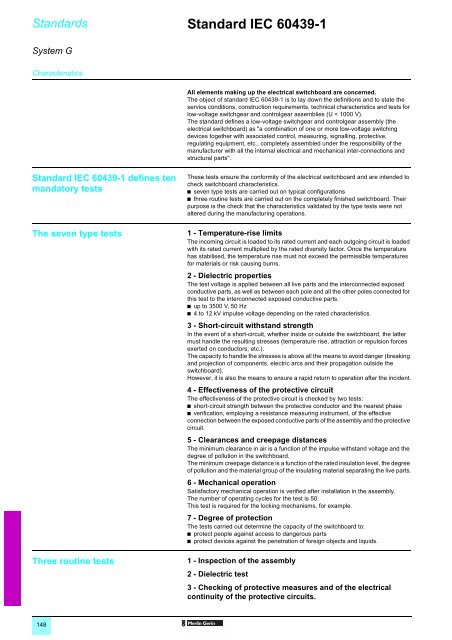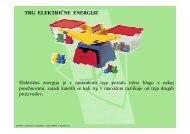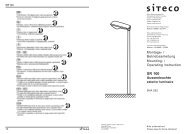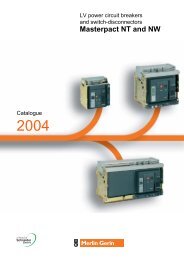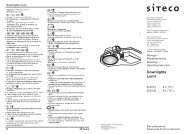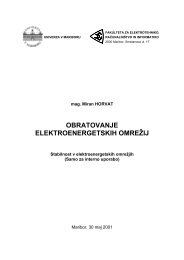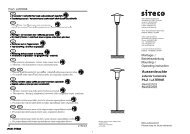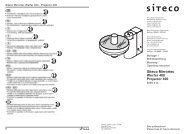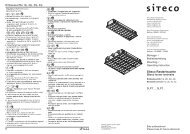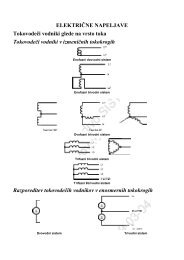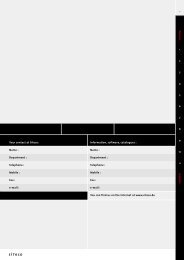Prisma Plus LV Switchboards - POWERLAB
Prisma Plus LV Switchboards - POWERLAB
Prisma Plus LV Switchboards - POWERLAB
- No tags were found...
Create successful ePaper yourself
Turn your PDF publications into a flip-book with our unique Google optimized e-Paper software.
Standards Standard IEC 60439-1System GCharacteristicsAll elements making up the electrical switchboard are concerned.The object of standard IEC 60439-1 is to lay down the definitions and to state theservice conditions, construction requirements, technical characteristics and tests forlow-voltage switchgear and controlgear assemblies (U < 1000 V).The standard defines a low-voltage switchgear and controlgear assembly (theelectrical switchboard) as "a combination of one or more low-voltage switchingdevices together with associated control, measuring, signalling, protective,regulating equipment, etc., completely assembled under the responsibility of themanufacturer with all the internal electrical and mechanical inter-connections andstructural parts".Standard IEC 60439-1 defines tenmandatory testsThe seven type testsThree routine testsThese tests ensure the conformity of the electrical switchboard and are intended tocheck switchboard characteristics.b seven type tests are carried out on typical configurationsb three routine tests are carried out on the completely finished switchboard. Theirpurpose is the check that the characteristics validated by the type tests were notaltered during the manufacturing operations.1 - Temperature-rise limitsThe incoming circuit is loaded to its rated current and each outgoing circuit is loadedwith its rated current multiplied by the rated diversity factor. Once the temperaturehas stabilised, the temperature rise must not exceed the permissible temperaturesfor materials or risk causing burns.2 - Dielectric propertiesThe test voltage is applied between all live parts and the interconnected exposedconductive parts, as well as between each pole and all the other poles connected forthis test to the interconnected exposed conductive parts.b up to 3500 V, 50 Hzb 4 to 12 kV impulse voltage depending on the rated characteristics.3 - Short-circuit withstand strengthIn the event of a short-circuit, whether inside or outside the switchboard, the lattermust handle the resulting stresses (temperature rise, attraction or repulsion forcesexerted on conductors, etc.).The capacity to handle the stresses is above all the means to avoid danger (breakingand projection of components, electric arcs and their propagation outside theswitchboard).However, it is also the means to ensure a rapid return to operation after the incident.4 - Effectiveness of the protective circuitThe effectiveness of the protective circuit is checked by two tests:b short-circuit strength between the protective conductor and the nearest phaseb verification, employing a resistance measuring instrument, of the effectiveconnection between the exposed conductive parts of the assembly and the protectivecircuit.5 - Clearances and creepage distancesThe minimum clearance in air is a function of the impulse withstand voltage and thedegree of pollution in the switchboard.The minimum creepage distance is a function of the rated insulation level, the degreeof pollution and the material group of the insulating material separating the live parts.6 - Mechanical operationSatisfactory mechanical operation is verified after installation in the assembly.The number of operating cycles for the test is 50.This test is required for the locking mechanisms, for example.7 - Degree of protectionThe tests carried out determine the capacity of the switchboard to:b protect people against access to dangerous partsb protect devices against the penetration of foreign objects and liquids.1 - Inspection of the assembly2 - Dielectric test3 - Checking of protective measures and of the electricalcontinuity of the protective circuits.148


